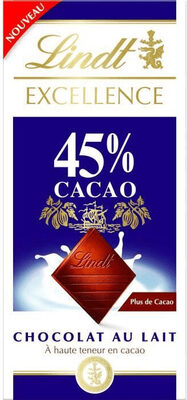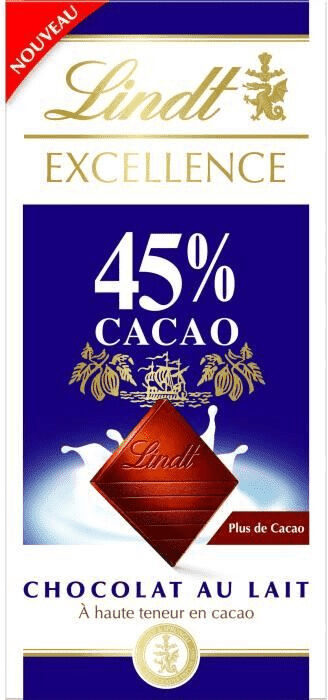Hjelp oss med å gjøre åpenhet om mat til det normale!
Som en ideell organisasjon, er vi avhengige av dine donasjoner for å fortsette å informere forbrukere verden over om hva de spiser.
Matrevolusjonen starter med deg!
Chocolat au lait 45% cacao - Lindt - 80 g
Chocolat au lait 45% cacao - Lindt - 80 g
Denne produktsiden er ikke fullstendig. Du kan hjelpe med å ferdigstille den ved å redigere den og legge til mere data fra bildene vi har, eller ved å ta flere bilder i appen for Android eller iPhone/iPad. Takk!
×
Strekkode: 4000539280405 (EAN / EAN-13)
Vanlig navn: tablette de chocolat au lait
Mengde: 80 g
Emballasje: en:Metal, en:Recyclable Metals, 41 ALU, en:Cardboard, 23 PBD
Kategorier: en:Snacks, en:Sweet snacks, en:Cocoa and its products, en:Chocolates, en:Milk chocolates
Etiketter, sertifiseringer, priser:
Grønt Punkt, Produsert i Tyskland
Ingrediensopprinnelse: Tyskland
Produksjon- eller behandlingssteder: Deutschland
Lenke til produktsiden på den offisielle nettsiden til produsenten: https://www.lindt.de/produkte/marken/exc...
Butikker: Chocolate Bar, Carrefour market, carrefour.fr
Land hvor produktet selges: Danmark, Finland, Frankrike, Tyskland, Norge, Sverige
Samsvarer med dine preferanser
Helse
Ingredienser
-
8 ingredienser
: pâte de cacao, sucre, beurre de cacao, poudre de crème, poudre de lait, émulsifiant (lécithine de soja),Cacao 45% minimumAllergener: Melk, SoyaSpor: Nøtter
Matprosessering
-
Ultrabearbeidede matvarer
Elementer som indikerer at produkter er i en:4 - Ultra processed food and drink products-gruppen:
- Tilsetningsstoff: E322 - Lecitiner
- Ingrediens: Emulgeringsmiddel
Matvarer er inndelt i 4 grupper i henhold til bearbeidingsgraden:
- Ubearbeidet eller minimalt bearbeidet mat
- Bearbeidede kulinariske ingredienser
- Bearbeidet mat
- Ultrabearbeidede matvarer
Bestemmelsen av gruppa er basert på kategorien til produktet og på ingrediensene den inneholder.
Tilsetningsstoffer
-
E322 - Lecitiner
Lecithin: Lecithin -UK: , US: , from the Greek lekithos, "egg yolk"- is a generic term to designate any group of yellow-brownish fatty substances occurring in animal and plant tissues, which are amphiphilic – they attract both water and fatty substances -and so are both hydrophilic and lipophilic-, and are used for smoothing food textures, dissolving powders -emulsifying-, homogenizing liquid mixtures, and repelling sticking materials.Lecithins are mixtures of glycerophospholipids including phosphatidylcholine, phosphatidylethanolamine, phosphatidylinositol, phosphatidylserine, and phosphatidic acid.Lecithin was first isolated in 1845 by the French chemist and pharmacist Theodore Gobley. In 1850, he named the phosphatidylcholine lécithine. Gobley originally isolated lecithin from egg yolk—λέκιθος lekithos is "egg yolk" in Ancient Greek—and established the complete chemical formula of phosphatidylcholine in 1874; in between, he had demonstrated the presence of lecithin in a variety of biological matters, including venous blood, in human lungs, bile, human brain tissue, fish eggs, fish roe, and chicken and sheep brain. Lecithin can easily be extracted chemically using solvents such as hexane, ethanol, acetone, petroleum ether, benzene, etc., or extraction can be done mechanically. It is usually available from sources such as soybeans, eggs, milk, marine sources, rapeseed, cottonseed, and sunflower. It has low solubility in water, but is an excellent emulsifier. In aqueous solution, its phospholipids can form either liposomes, bilayer sheets, micelles, or lamellar structures, depending on hydration and temperature. This results in a type of surfactant that usually is classified as amphipathic. Lecithin is sold as a food additive and dietary supplement. In cooking, it is sometimes used as an emulsifier and to prevent sticking, for example in nonstick cooking spray.Kilde: Wikipedia (Engelsk)
-
E322i
Lecithin: Lecithin -UK: , US: , from the Greek lekithos, "egg yolk"- is a generic term to designate any group of yellow-brownish fatty substances occurring in animal and plant tissues, which are amphiphilic – they attract both water and fatty substances -and so are both hydrophilic and lipophilic-, and are used for smoothing food textures, dissolving powders -emulsifying-, homogenizing liquid mixtures, and repelling sticking materials.Lecithins are mixtures of glycerophospholipids including phosphatidylcholine, phosphatidylethanolamine, phosphatidylinositol, phosphatidylserine, and phosphatidic acid.Lecithin was first isolated in 1845 by the French chemist and pharmacist Theodore Gobley. In 1850, he named the phosphatidylcholine lécithine. Gobley originally isolated lecithin from egg yolk—λέκιθος lekithos is "egg yolk" in Ancient Greek—and established the complete chemical formula of phosphatidylcholine in 1874; in between, he had demonstrated the presence of lecithin in a variety of biological matters, including venous blood, in human lungs, bile, human brain tissue, fish eggs, fish roe, and chicken and sheep brain. Lecithin can easily be extracted chemically using solvents such as hexane, ethanol, acetone, petroleum ether, benzene, etc., or extraction can be done mechanically. It is usually available from sources such as soybeans, eggs, milk, marine sources, rapeseed, cottonseed, and sunflower. It has low solubility in water, but is an excellent emulsifier. In aqueous solution, its phospholipids can form either liposomes, bilayer sheets, micelles, or lamellar structures, depending on hydration and temperature. This results in a type of surfactant that usually is classified as amphipathic. Lecithin is sold as a food additive and dietary supplement. In cooking, it is sometimes used as an emulsifier and to prevent sticking, for example in nonstick cooking spray.Kilde: Wikipedia (Engelsk)
Analyse av ingredienser:
-
en:Palm oil free
Ingen ingredienser som inneholder palmeolje ble oppdaget
-
en:Non-vegan
Ikke-veganske ingredienser: Fløte, Melkepulver
-
en:Vegetarian
Ingen ikke-vegetarianske ingredienser funnet
-
Detaljer fra analysen av ingrediensene
: pâte de cacao, sucre, beurre de cacao, crème, poudre de lait, émulsifiant (lécithine de soja), Cacao 45%- pâte de cacao -> en:cocoa-paste - vegan: yes - vegetarian: yes - ciqual_proxy_food_code: 16030
- sucre -> en:sugar - vegan: yes - vegetarian: yes - ciqual_proxy_food_code: 31016
- beurre de cacao -> en:cocoa-butter - vegan: yes - vegetarian: yes - ciqual_food_code: 16030
- crème -> en:cream - vegan: no - vegetarian: yes - ciqual_food_code: 19402
- poudre de lait -> en:milk-powder - vegan: no - vegetarian: yes - ciqual_proxy_food_code: 19044
- émulsifiant -> en:emulsifier
- lécithine de soja -> en:soya-lecithin - vegan: yes - vegetarian: yes - ciqual_food_code: 42200
- Cacao -> en:cocoa - vegan: yes - vegetarian: yes - ciqual_proxy_food_code: 18100 - percent: 45
Ernæring
-
Dårlig ernæringskvalitet
⚠ ️Advarsel: mengden fiberer ikke spesifisert, deres mulige positive bidrag til karakteren kunne ikke tas med i betraktningen.⚠ ️Advarsel: mengden frukt, grønnsaker og nøtter er ikke spesifisert på etiketten, den ble anslått utfra ingredienslista: 0Dette produktet regnes ikke som en drikke under beregningen av Nutri-Score.
Positive poeng: 0
- Protein: 5 / 5 (verdi: 9.1, avrundet verdi: 9.1)
- Fiber: 0 / 5 (verdi: 0, avrundet verdi: 0)
- Frukt, grønnsaker, nøtter, og raps/valnøtt/olivenoljer: 0 / 5 (verdi: 0, avrundet verdi: 0)
Negative poeng: 25
- Energi: 7 / 10 (verdi: 2380, avrundet verdi: 2380)
- Sukker: 8 / 10 (verdi: 39, avrundet verdi: 39)
- Mettet fett: 10 / 10 (verdi: 25, avrundet verdi: 25)
- Natrium: 0 / 10 (verdi: 76, avrundet verdi: 76)
Poengene for proteiner telles ikke fordi de negative poengene er større eller lik 11.
Ernæringsverdi: (25 - 0)
Nutri-Score:
-
Næringsnivåer
-
Fett i høy kvantitet (40%)
Fint å vite- Et høyt inntak av fett, spesielt mettet fett, kan øke kolesterolet, som øker risikoen for hjertesjukdommer.
Anbefaling: Reduser inntaket av fett og mettet fett- Velg produkter med lavere fett- og mettet fettinnhold.
-
Mettet fett i høy kvantitet (25%)
Fint å vite- Et høyt inntak av fett, spesielt mettet fett, kan øke kolesterolet, som øker risikoen for hjertesjukdommer.
Anbefaling: Reduser inntaket av fett og mettet fett- Velg produkter med lavere fett- og mettet fettinnhold.
-
Sukkerarter i høy kvantitet (39%)
Fint å vite- Et høyt inntak av sukker kan føre til økning i vekt og tannråte. Det øker også risikoen for diabetes type 2 og hjerte- og karsjukdommer.
Anbefaling: Begrens inntaket av sukker og sukkerholdige drikker- Sukkerholdige drikker (som brus, fruktdrikker, og fruktjuicer og nektar) burde begrenses så mye som mulig (ikke mer enn 1 glass om dagen).
- Velg produkter med lavt sukkerinnhold og reduser inntaket av produkter med tilsatt sukker.
-
Salt i liten kvantitet (0.19%)
Fint å vite- Et høyt inntak av salt (eller sodium) kan føre til et økt blodtrykk, som kan føre til høyere risiko for hjertesjukdom og slag.
- Mange folk har høyt blodtrykk uten å vite det, siden det ofte ikke er noen symptomer.
- De fleste inntar for mye salt (i gjennomsnitt 9 til 12 gram per dag), cirka det dobbelte av den anbefalte høyeste mengden av inntak.
Anbefaling: Begrens inntaket av salt og saltet mat- Reduser mengden salt som brukes ved matlaging, og ikke salt igjen ved bordet.
- Begrens inntaket av salte snacks og velg produkter med lavere saltinnhold.
-
-
Ernæringsinnhold
Ernæringsinnhold Som solgt
for 100 g / 100 mlSammenlignet med: en:Milk chocolates Energi 2 380 kj
(572 kcal)+3 % Fett 40 g +21 % Mettet fett 25 g +28 % Karbohydrat 41 g −24 % Sukkerarter 39 g −25 % Kostfiber ? Protein 9,1 g +24 % Salt 0,19 g −12 % Fruits‚ vegetables‚ nuts and rapeseed‚ walnut and olive oils (estimate from ingredients list analysis) 0 % Cocoa (minimum) 45 %
Miljø
-
Eco-Score C - Moderat miljøavtrykk
Eco-Scoren er en eksperimentell poengsum som oppsummerer miljøavtrykket til matprodukter.→ Eco-Scoren ble opprinnelig utviklet for Frankrike og den blir nå utvidet til andre europeiske land. Eco-Score-formelen er i stadig endring og forbedres jevnlig for å gjøre den mer presis og bedre egnet til hvert land.Livssyklusanalyse
-
Gjennomsnittlig avtrykk for produkter i samme kategori: D (Score: 38/100)
Kategori: Milk chocolate bar
Kategori: Milk chocolate bar
- PEF-miljøscore: 0.78 (jo lavere poengsum, jo lavere avtrykk)
- inkludert innvirkning på klimaendringer: 12.74 kg CO2-ekv./kg produkt
Trinn Påvirkning Landbruk
43.5 %Bearbeiding
50.8 %Emballasje
1.3 %Transport
3.7 %Distribusjon
0.6 %Forbruk
0.0 %
Fordeler og ulemper
-
Opprinnelsene til ingredienser med moderat avtrykk
Fordel: +11
Miljøpolicy: +4
Transport: +7
Opprinnelsen til produktet og/eller dets ingredienser % av ingredienser Påvirkning Tyskland 100 %Moderat
-
Emballasje med lavt avtrykk
Ulempe: -4
Form Material Resirkulering Påvirkning Unknown Heavy aluminium Gjenvinnes Moderat Unknown 23 PBD Lav ⚠ ️ Informasjonen om emballasjen til dette produktet er ikke tilstrekkelig presis (eksakte former og materialer av alle komponenter i emballasjen).⚠ ️ For en mer presis beregning av Eco-Scoren, kan du modifisere produktsiden og legge dem til.
Hvis du er produsenten av produktet, kan du sende oss informasjon gjennom vår gratis plattform for produsenter.
Eco-Score for dette produktet
-
Avtrykk for dette produktet: C (Score: 45/100)
Produkt: Chocolat au lait 45% cacao - Lindt - 80 g
Livssyklusanalysescore: 38
Sum av fordeler og ulemper: +7
Endelig poengsum: 45/100
-
Carbon footprint
-
Likt som å kjøre 6.6 km i en bensinbil
1274 g CO² per 100g produkt
Karbonutslippstallet kommer fra ADEME's Agribalyse database, for kategorien: Milk chocolate bar (Kilde: Ademe Agribalyse Database)
Trinn Påvirkning Landbruk
31.2 %Bearbeiding
65.4 %Emballasje
0.8 %Transport
2.4 %Distribusjon
0.1 %Forbruk
0.0 %
Emballasje
-
Emballasje med lavt avtrykk
-
Emballasjedeler
(41 ALU)
(23 PBD)
-
Emballasjematerialer
Material % Emballasjevekt Emballasjevekt per 100 g produkt Paper or cardboard Metal Total
-
Transport
-
Opprinnelsen til ingredienser
Opprinnelsene til ingredienser med moderat avtrykk
Opprinnelsen til produktet og/eller dets ingredienser % av ingredienser Påvirkning Tyskland 100 %Moderat
Report a problem
-
Incomplete or incorrect information?
Category, labels, ingredients, allergens, nutritional information, photos etc.
If the information does not match the information on the packaging, please complete or correct it. Open Food Facts is a collaborative database, and every contribution is useful for all.
Datakilder
Produkt lagt til av kiliweb
Siste redigering av produktsiden den av ecoscore-impact-estimator.
Produktside også redigert av charlesnepote, citrullus28, dahlqvist, didierg, driveoff, inf, jumati, moon-rabbit, openfoodfacts-contributors, packbot, quechoisir, roboto-app, yuka.RnEwWkt2OG9vTjBhdXNVQzNBSHAyOG9sK2FLSGNHL3BNdlFPSVE9PQ, yuka.ZmI0akw3NFluZkFWd3NRdTFCR0pxK3RVbDdpWmNINlNMY01QSVE9PQ, yuka.sY2b0xO6T85zoF3NwEKvlmZnaeL_mwLfOBLfiFLVw9acMKXxQ_dQuaSga6s.










